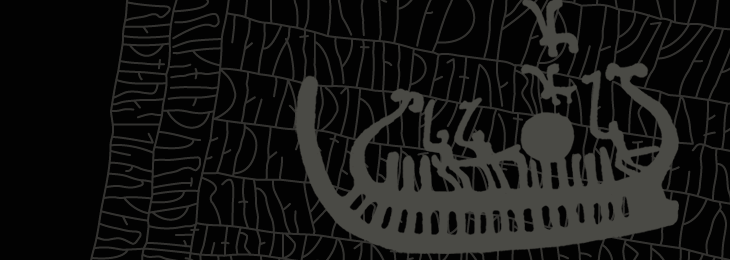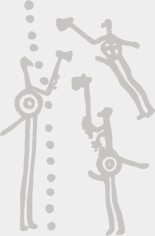Beowulf and the Performance of Medieval Epic
By Benjamin Bagby
This text is excerpted from the essay: “Beowulf, the Edda, and the Performance of Medieval Epic: Notes from the workshop of a reconstructed ‘singer of tales’”, in Performing Oral Narrative (eds. Nancy Regalado and Evelyn Vitz), published by Boydell & Brewer in 2005.
Regardless of the historical period of music which interests us, the concept of ‘historically informed performance’ thrives on the conviction that today’s performers can find knowledge and instruction in the documentation which has survived from past musical practices. However, the concept becomes much more complex and clouded when we seek to perform the musical arts of early medieval cultures which were largely pre-literate, which knew neither notation nor treatises, and from which we possess only a few descriptions of performance or surviving fragments of instruments. The notationless world of medieval epic song is one such musical culture. What kinds of witnesses have survived from the early Middle Ages which we might use to reconstruct a performance art that has been silent for a thousand years and more? Are there other sources of information to which we might turn in making such an attempt? These are some of the questions I have tried to answer in my re-constructions of northern European oral epics such as the Anglo-Saxon Beowuf.
Although it is generally accepted – based largely on descriptions of performance situations – that medieval epic poetry was the domain of tribal or itinerant bardic entertainers, no written musical sources of epic poems dating from the early Middle Ages are known to exist. In fact, we would have no reason to expect such sources to have been written at all. The milieu in which these poems were originally transmitted, sung, and acted out was that of a uniquely oral culture, and professional singerspassed on repertoires and techniques from generation to generation without the hindrance and expense of writing.
The subtle flexibility of modal song is especially suitable as a vehicle for narrative: the vocalist makes use of a seemingly simple matrix of tones to support an infinitely complex textual structure, so that all elements – tone, text and performer – merge into one organic process which functions uniquely in the service of the story. For this task, all aspects of the singer’s art are called into use, including the wide and flexible spectrum of vocal utterance: plain speech, heightened speech, sung speech, spoken song, simple syllabic song, melismatic song; as well as the more radical elements of human vocal sound: whispering, moaning, groaning, hoarse speech, barking, shouting and, yes, even a scream when it’s called for in the story. In addition, the ‘singer of tales’ functions in close physical proximity to his/her listeners; the singer’s entire body, including hands and feet, which are also sources of sound, is part of the instrumentum which serves the story. And speaking of instruments: the possible addition of an actual instrumental partner (whether a separate instrumentalist or self-accompanied) allows for expanded elements of dialogue, commentary, support and interlude, all of which only serve to make the modal character richer, the narrative denser, more focussed. When examining oral epics as they are still sung today in various cultures, one hears a surprisingly similar attitude to the usage of modal structures in vocal style, vocal usage, and instrumental participation.
The metrical genius and sophistication of alliterative Germanic poetry is apparent to anyone who has come into contact with works such as the Eddic poems or Beowulf, yet, as a performer, the issue which interests me is this: how would such metrical structures have expressed themselves in performance, in a culture which hardly knew reading and writing, and which certainly did not know musical notational systems? Our relationship to Beowulf is based on a ‘literate’ course of study: readings, analyses and exercises, using textbooks, editions, translations and manuscript facsimiles. There is no one alive today who has learned this poetic art as a uniquely oral phenomenon.
As a performer of metrically-structured texts, I do experience the metrics on a very deep level as I sing and speak the story; they are influencing and shaping my use of voice, instrumental accompaniment, timing, speed and rhetorical gesture, in short, all of the variables of performance. Assuming a small medieval audience of cognoscenti who had heard a given story already dozens – if not hundreds – of times, there would be among the listeners a subtle appreciation of the text’s inner structures, even a certain delight in the singer’s masking of the obvious, and in the performance’s interplay of sounds, patterns, and meaning. I work to create metrically-aware performances of Beowulf, based on a written source, but aiming to re-create the spirit of an oral poem performed in a notationless culture. My goal is to allow the metrical structures their important place in the text, but that they should function subtly, creatively, almost subconsciously. All elements of measured time must be free to help shape the story: from the smallest unit of the individual syllable to the single, long pulse of an entire performance.
Equally important in these musical reconstructions are the instruments, especially the harp, which is mentioned in early northern souces describing or depicting music-making. The harp used for Beowulf is a copy based on the remains of an instrument found in a 7th-century Allemanic burial site in Oberflacht (Germany). This Germanic harpa is often referred to as a lyre in our time, in order to differentiate it from the triangular cithara (with its distinctive front pillar,which we still recognize as the most common harp form). Such instruments usually have very few strings (the Oberflacht instrument probably had six), and the possible tuning systems – based on medieval theories of consonance, scraps of information from medieval sources, the limitations of medieval string technology, and harp-tuning traditions from other cultures – yield a series of basic intervals which in turn can inform the text being accompanied. I believe we can say that a 6-string harp such as Oberflacht was tuned according to some kind of system of tones yielding a certain number of consonant intervals (the principle intervals being the octave, perfect 5th and perfect 4th); this would be consistent both with the laws of physics and with the theoretical European concepts of consonance inherited from antiquity. Even for a Germanic bard who had never heard of Pythagoras or Boethius, we could expect certain consonant intervals to sound between the various strings of his harp. There are several plausible tunings which would yield these intervals in various combinations. The tuning system of any such instrument will be closely related to the mode which the tradition of the song demands, so that the instrument must sometimes be re-tuned to accompany in a new mode.
Regarding playing technique, it hardly needs stating that an instrument of six strings is not suited to playing the elaborate melodies with accompanying chords which we tend to associate with later harps. Instead, we have here a harp type (such as is still known and played in non-European musical cultures, especially in Africa) which has as its means of expression the use of pattern, inversion and variation, and on the ‘playing out’ of modal vocabularies. Since one hand must hold the instrument upright on the player’s knee, there can only be one principle playing hand, although several players have found that the holding hand can easily spare a thumb to thicken up the patterns by emphasizing the top strings; some iconographic evidence (especially depictions of King David playing the cithara) might even point to such a practice. Just as the singers rely on a small repertoire of potent modal gestures for the vocalization of their texts (the ‘matrix’ I mentioned earlier), the harp makes a virtue of its seeming limitations and, like an interlaced Viking design, brings a richness of articulation to the expression of the mode, and hence to the telling of the story.
We can never know if our performances precisely duplicate the art of a particular medieval bard; nor can we ever rediscover the ‘original melody’ to which any epics were sung in the early Middle Ages, since the original melody certainly never existed for any one narrative or story. In each local tradition, in each language and dialect there were varieties of originals being passed along in their own oral traditions. However, I am convinced that by making careful use of specific information and techniques, as described here, coupled with an intuitive spirit based on a working knowledge of both medieval song and the essence of sung oral poetry, it is possible to reconstruct highly plausible performance models which allow our venerable ancestral stories to live again.


